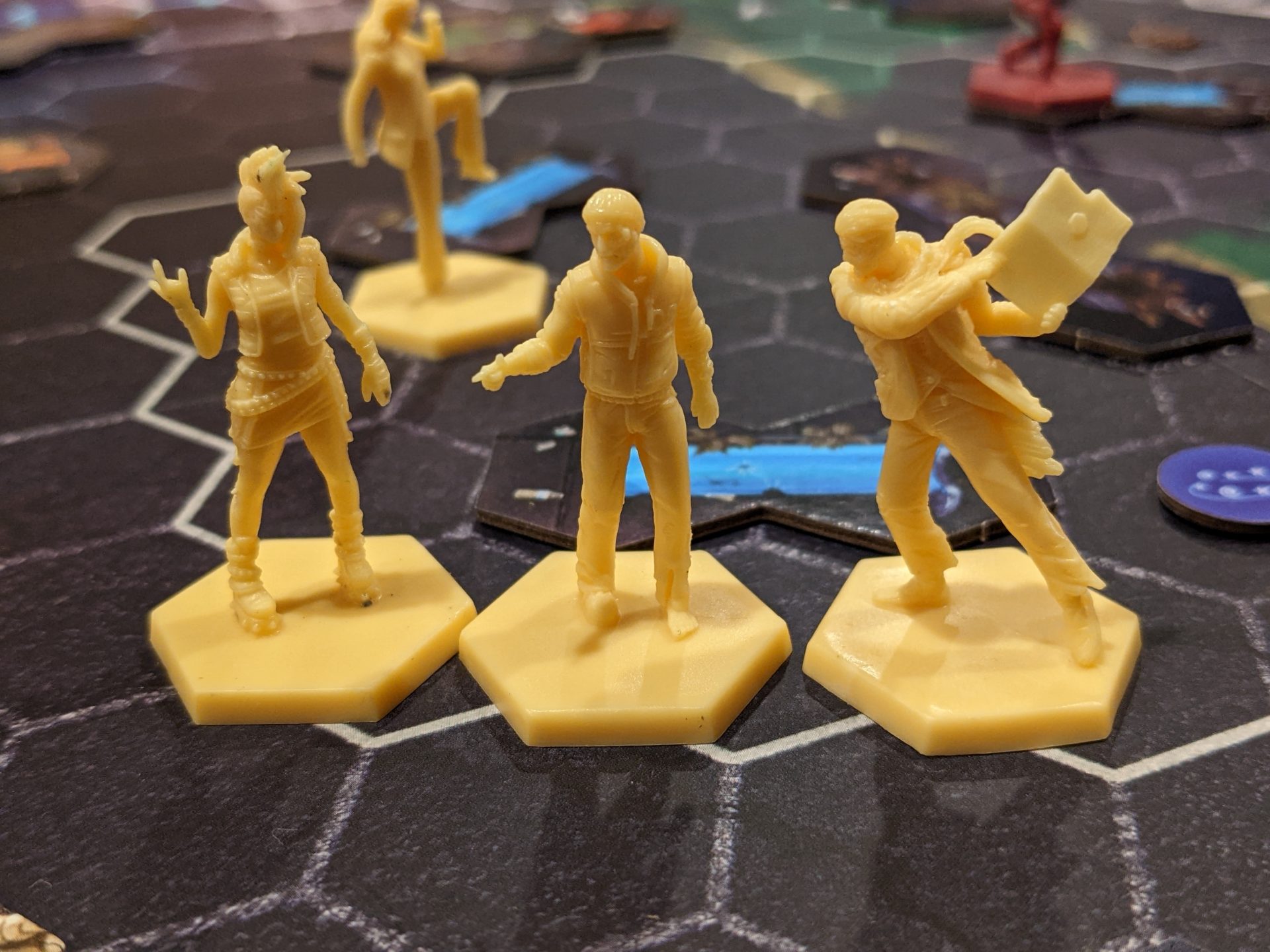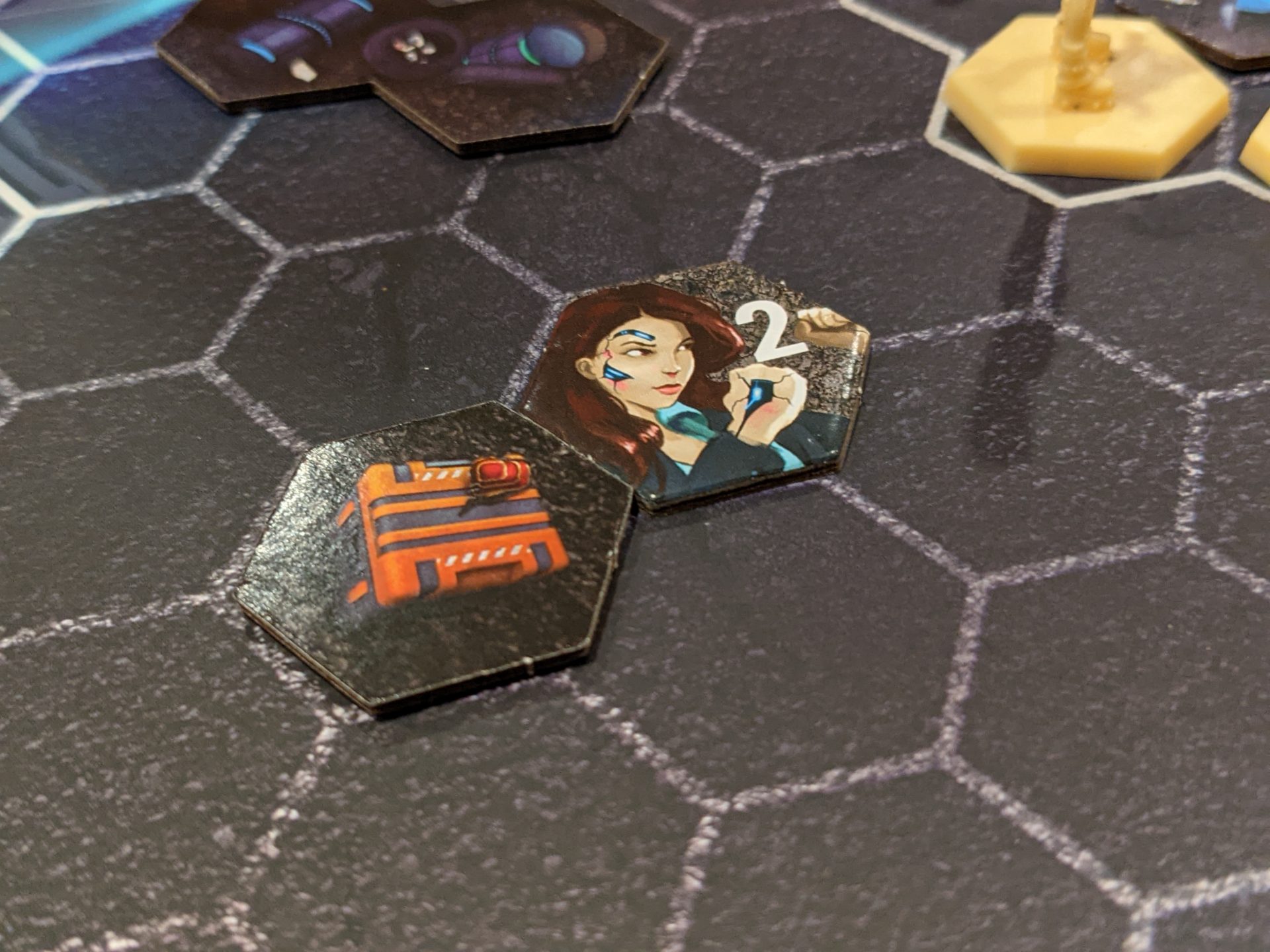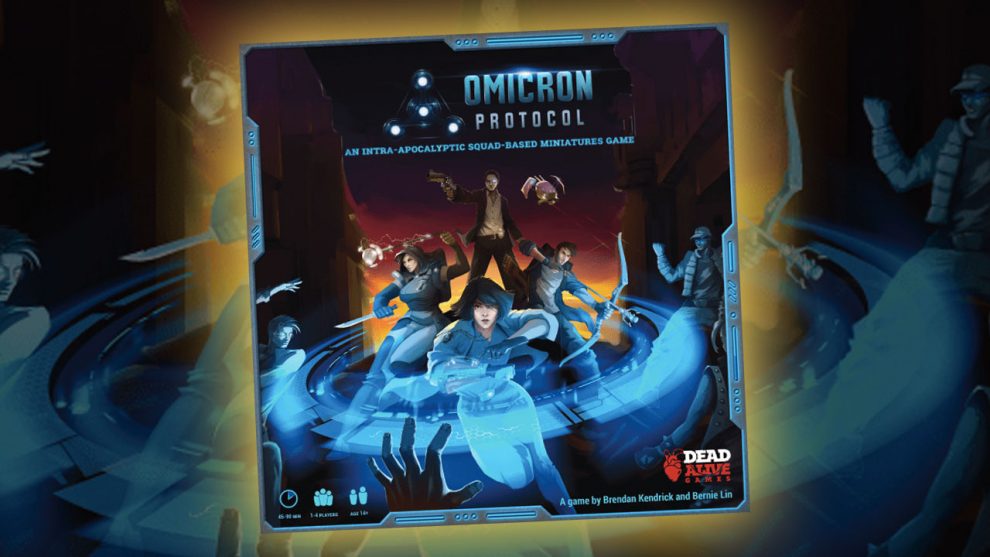Disclosure: Meeple Mountain received a free copy of this product in exchange for an honest, unbiased review. This review is not intended to be an endorsement.
I am a lucky man; I get to meet creative people all the time, and many of them make board games. How cool is that?
While at GAMA Expo back in March, I did some speed networking with different designers and publishers, many of whom I had the chance to meet for the first time. One of those people was Bernie Lin, the co-designer of a game called Omicron Protocol (2022, Dead Alive Games); the prototype for Omicron Protocol was available to view during the expo.
Omicron Protocol had miniatures, “atmosphere”, and a squad-based system for combat that could be played solo, co-op, or competitively. Then my mind went down memory lane to Core Space, a release I picked up during COVID from Battle Systems. Core Space has a sci-fi theme, minis, an excellent action point and ability system, and some of the best 3-D terrain I have ever seen in a skirmish game.
Omicron Protocol swaps out 3-D terrain for flat tiles to serve as cover, objectives, dumpsters, medical tents, and the like. I got excited for the game to arrive, but it took me a few weeks to work through a review copy backlog to get it to the table.
Stepping back from the overall experience, Omicron Protocol does just a bit more right than wrong. The best thing it does: the game never overstays its welcome. But just barely.

Let’s Talk About the Rulebooks
Sometimes our reviews here at Meeple Mountain provide a partial rundown of the rules of a given game.
Omicron Protocol? I can’t possibly summarize all the rules, because there are literally FOUR rulebooks: a Quick Start Guide (QSG), a How to Play (H2P), a Rules Reference and Scenario Guide (RRS) and a Solo/Cooperative Rulebook (SCR). All in, there are more than 100 pages of rules.
That said, here’s what I will grant the folks at Dead Alive Games about these rulebooks: they are excellent, at least individually.
For people new to the idea of hex-based combat, line-of-sight, “area of effect”, “attack of opportunity”, and other terms unlikely to be familiar to casual gamers, Omicron Protocol does a fantastic job of setting the stage. The QSG walks through a couple rounds of a new game, and they spell out every last detail in a very digestible way for someone new to this format.
H2P builds gradually on QSG, and I loved the way H2P introduced just a little more into the format. Ideally the publisher would combine the QSG and H2P into one booklet, but that’s because I’m probably a 4 out of 10 on the minis combat scale, as an owner of games like Arcadia Quest and Wildlands. I know my way around, but I’m not an all-time expert.
These manuals are very well written, and it is easy to find what you need in each booklet. The problems arise when you need to find a rule, and you find yourself torn: I could probably find that in the RRS, but it will be faster to look in the H2P, right? There is a lot of information, and having it scattered across 4 manuals leaves some questions harder to answer in a pinch.
This is mitigated slightly by the excellent player reference cards, even though the print is tiny. Most of what you will need can be found on mission cards, character cards and the player aid, but you’re going to occasionally hunt for better explanations.

The Game: It’s Short
Omicron Protocol never overstayed its welcome across my competitive and solo plays, but it came very close.
My multiplayer games were about 90 minutes, and my solo plays were 30-40 minutes each. That, combined with a very easy setup and teardown, made me happy. The playtime on the box also aligns with my experience. Omicron Protocol will ultimately be a one-hour skirmish at two or three players once you know what you are doing.
Of the eight included scenarios, I tried 4 of them; all aligned with roughly the same format. Depending on the number of players, each player has control of 1-2 characters from one of the two factions in the game, the Peacekeepers and the Survivalists. Whoever is the first to 3 points or has the most points after 3-4 rounds will win.
In all the scenarios, scoring points comes down to KO-ing non-friendly characters, achieving scenario objectives, and/or killing zombies—in Omicron Protocol, those zombies are Cyber-Memetic Sociopaths, or CyMS. Using a mix of cover, weapons and abilities to stay out of harm’s way, the game pushes action over thinky strategy by using each round’s action points to get going fast.
The shining star in Omicron Protocol is the “Action Store.” Each character has weapons and abilities that are triggered by the number of hits you roll based on your attack value against a target’s dexterity value. Then these hits can be assigned in a few different ways; maybe you’ll roll five dice, get 4 hits, then use 2 of the hits to cause melee damage to another character, then use 2 hits to grant a one-time ability.
Or, you could roll those same five dice, and if you only got 3 hits, use a Luck token (earned somewhat easily through attack rolls) to bump one of your dice up a pip, turning it into a hit. Then you could use all 4 hits to incur more damage on a target.
Some of these abilities are really cool—many of the characters have mind-control powers or ways to use area-of-effect attacks that spread damage across a wide swath of hexes. One character I used in a game had attack elements that stack, which allowed me to have six or even seven attack dice if I kept attacking all round long.
So, the Action Store is cool. However, in competitive mode, killing zombies turn after turn wasn’t that much fun. (Also, they are zombies; sigh. I can’t wait for this generation of zombie games to end. It WILL end, right?) Attacking player characters sounds cool, but high-health characters can prove difficult to kill without some pretty serious help.
And there are some crazy combinations of abilities that make certain two-character setups really tough. One of the fetch quests I played with a partner against a human player controlling two characters got hard fast; the single human player was able to grab an objective token in the center of the map, then played keep away long enough to score a point for holding the objective, a point for having area control of the central set of hexes, and she killed off five CyMS, which granted her an extra point.
And just like that, our game was over!

Solo Play
Omicron Protocol opens up a bit with solo play thanks to a single change: the six different types of CyMS suddenly have differing powers, based on cards used for solo or cooperative multiplayer experiences.
Now, I’m not sure I can explain to you why the zombie type which looks like a woman carrying an expensive purse is so drastically different than a zombie type which looks like a guy carrying a bunch of notes in a binder. But in solo play, Dead Alive Games does something cool with the zombies: powers are granted, and they stack with the number of that type of CyMS already on the board.
Drawn from a deck each time any character activates, this led to some really funny sequences because I’d have the CyMS punk rock type come into the game, then come in again (without my killing any of the other previous punk rock guys), then enter the game a third time. That meant each punk rock zombie woman in the game had not one, but THREE powers that made life difficult if you were near them.
This also gives the game some real legs as you try to work out how to get those zombies out of the way, while also granting all players more chances to score points through CyMS kills.
Don’t get me wrong—we are still talking mostly about zombies. Yes, they move slow, only 2-3 hexes per turn based on their rules at any given time. They don’t attack with many dice. It’s easy to predict where they will go, at least on the Normal difficulty level. You’re probably not getting overwhelmed with CyMS.
The solo game does a decent job of informing some of the tactical decisions you’ll have to make against other human players. And like the competitive version of the game, you will wrap up quickly.
First you’ll have to decide if all of this is for you.

Where Do I Land?
I mentioned a game called Core Space earlier. Core Space was an interesting challenge for me: the environment, the terrain, the atmosphere, and the combat system are all excellent. The initial bad guys in that box were varied and interesting. It played fast, with games taking about an hour.
But it was an absolute pain in the rear to set up. Sometimes, it could take 30 minutes to get the board, terrain, and player boards ready to go. That led to some real anguish: I would look at the box, get tired just at the idea of setting Core Space up, then would go back to watching TV or playing video games.
Omicron Protocol can get onto the table in 10 minutes, now that I recognize which terrain types should go where. But save for the Action Store, the skirmish elements are only OK. The scenarios are fine, but I haven’t found one yet that I want to keep going back to. I like trying out the combinations of characters on each of the two factions, but not enough that I’m really excited to try it again.
Some of the once-per-game powers of the factions in Omicron Protocol are cool; with the Survivalists, their power in solo play during a fetch quest like Supply Line is overpowered—a smart player could bunch their faction together to gain a one-time 5-hex move to get supplies out of the city.
I just wish Omicron Protocol had more options here. Core Space had better gear available to be found during forage actions on the map. In Omicron Protocol, the act of getting loot simply isn’t there, and in its place you can draw from a deck of Forage cards that grant minor one-time effects.
Wouldn’t it be great if you could swap out your weapons during play? Face even minor boss-like characters that could be controlled by the active player to mess with opponents?
Omicron Protocol is not a bad game; the issue here is that it is not crazy exciting. And for an MSRP of $100, I need a little more excitement to warrant the price.
Omicron Protocol has expansion content inbound, and I think that will help round out the package, especially with additional characters, factions (and faction powers), loot, and non-playable enemies that can spice up the strategy. The Action Store is a winner, but I wish there was more exceptional design going on in this game.












Add Comment